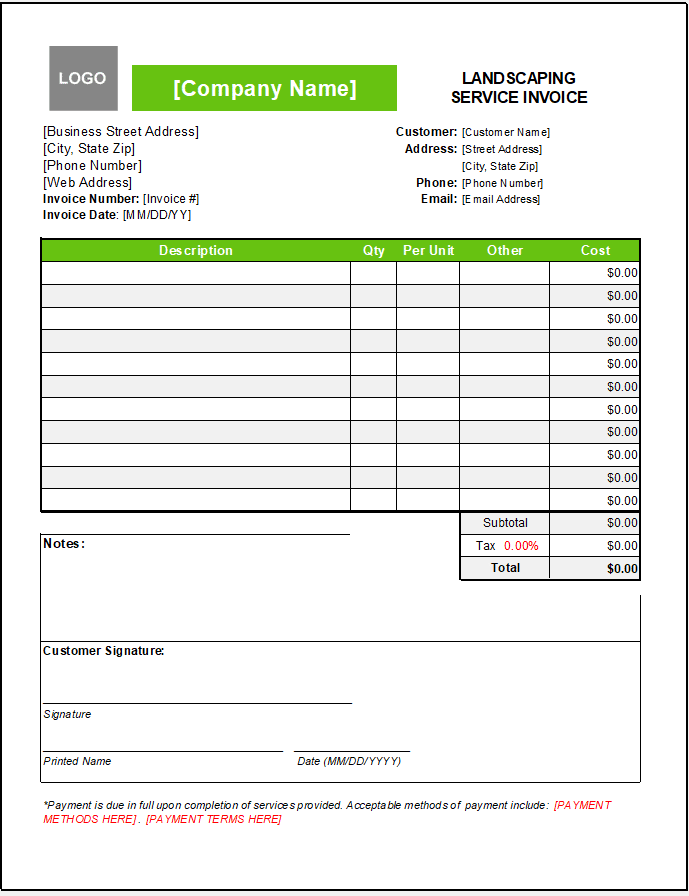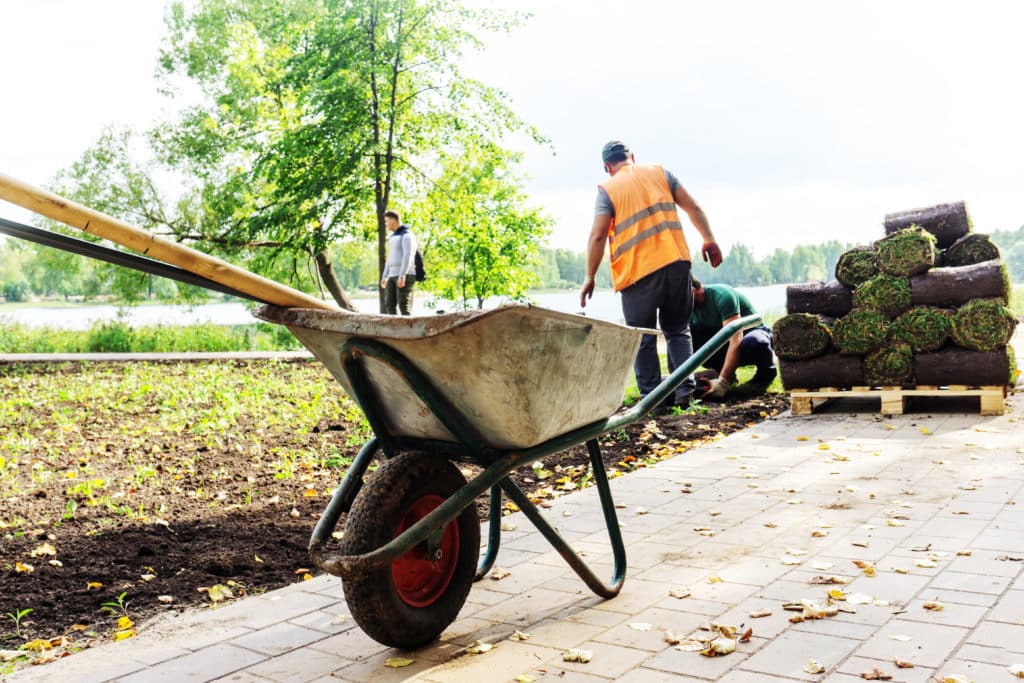How to Write an Invoice for Construction Work (with Free Template)
Your billing process can significantly impact your customer’s experience. For example, a professionally formatted invoice for landscaping jobs can reduce billing questions and improve clarity. As a result, your customers can see precisely what they are paying for and how much it costs in black and white, which mitigates the risk of a misunderstanding or disagreement.
In addition, an invoice outlines accepted payment options, giving your customer all the information needed to make a prompt and accurate payment to your business.
What needs to be included in your Landscaping invoice?
Invoicing is critical to your business’s cash flow, so how do you invoice for landscaping services? Here’s a breakdown of the critical elements of a landscaper’s invoice, which you can use to shape your invoice for landscaping jobs and reap the benefits:
- Business name and address: If you are the sole proprietor, your full name may be your business name. And, if you are like most landscapers, you don’t have business premises. In that case, the address may be a PO Box or your home address.
- Client name and address: Remember that the client’s address may not necessarily be the premises you worked on. For example, a son may hire a landscaper to mow the lawn for his elderly mother. The client’s address would be the son’s address.
- Project address: This is the address of the premises you worked on. So, using the example above, it would be the elderly mother’s address.
- Invoice number: An invoice number is a unique identifying code that allows you to track and reference your invoices. You can generate invoice numbers manually using your chosen system or automatically through accounting software. Some standard invoice numbering techniques include:
- Sequential invoice numbers (e.g., 0001, 0002, 0003)
- Date invoice numbers (e.g., 040522-001, 050522-002)
- Client name invoice numbers (e.g., MJ-0001, RS-0002)
- Invoice date: This is the date the invoice was created and issued.
- Line-Item description: Briefly describe the landscape services delivered (e.g., removed tree, ground stump, and mulched branches).
- Hours worked: Only include your hours if you charge an hourly rate.
- Amount due: If you provided several services, include the price of each service. Then, calculate the total amount due.
- Tax: If taxes apply to your services, include the taxable amount on your invoice.
- Customer Signature: Having a signed copy of your invoice can offer more definitive proof of customer acceptance if issues arise with payment.
- Payment information: This is generally included at the bottom of the invoice and details your accepted payment methods, such as credit card and direct debit.
- Payment terms: Payment terms include the payment due date, any incentives for early payment (e.g., a discount), and any penalties for late payment (e.g., late fees).
5 tips for creating professional invoices
- Make sure you include your contact information, as well as the customer's contact information.
- Make sure the invoice is easy to read, with clear headings and sections.
- Make sure you list what services were provided, as well as the corresponding prices.
- Make sure you include any applicable taxes or discounts.
- Make sure the invoice is dated and includes a payment terms section.
Free Landscaping Invoice Template
For most businesses, landscapers included, cash flow is key to unlocking sustainable success. It would be best if you got paid in full and on time to continue delivering your services, and professional landscaping invoice templates can help with exactly that.

Here’s what a professional landscaping invoice template can do for your business:
- A professional template can help you list the total amount owed clearly, so there’s no confusion and back-and-forth with your client.
- Invoice templates allow you to more easily detail payment options and instructions, minimizing friction and encouraging fast payment.
- Invoice templates can include areas for payment terms, which set more firm due dates and, in some cases, late fees to further encourage prompt payments.
- A branded template helps you represent your business with a degree of professionalism that generic written invoices cannot.
The right invoicing process protects your business’s cash flow while giving your customers the details they need for their personal records. It’s a win-win.
Need a more sophisticated landscaping invoice?
Joist allows you to create and send invoices in minutes with the easy-to-use mobile invoicing & estimating tool. You can create estimates, convert them to customizable invoices, and offer your customers flexible payment methods. Joist’s professional Landscaping invoices help you to simplify your finances and spend more time focusing on your clients.

General Invoicing Tips for Landscapers
When creating invoices, it’s important to make them as professional as possible and maintain that professionalism throughout how you manage those invoices and corresponding payments. Here are some tips to help support this:
Use an Invoice Management System
An invoice management system, or IMS, is a software program that allows you to create and manage invoices online. This can be done on any web-connected device, making it easy to keep track of your work and get paid quickly. Most of these systems also offer features like invoice tracking and payment history, so you can keep tabs on your business finances with ease. If you’re looking for an easy way to streamline your invoice process, then an IMS may be the right solution for you.
In order to make the process of invoicing as painless as possible, many landscapers are turning to invoice management systems. These systems allow you to create custom invoices on any web-connected device, making it easy to manage your work and get paid faster.
Another benefit of using an invoice management system is that you can get customer payments in real time, via email. This means you can get paid for your work as soon as it’s completed, rather than having to wait for a check in the mail.
You can use an invoice management system to store all your customer contacts and documents securely in your account. This makes it easy to keep track of clients you’ve worked with and contact them again in the future for additional jobs.
3 tips for storing customer contacts
- Make sure you include all the necessary contact information, including name, email address, and phone number.
- Make sure you store customer contacts in a secure location.
- Make sure you keep track of which customers have already been invoiced and which of them have paid.
Build Better Estimates
Estimates are an important part of any landscaping business. More accurate estimates help you to get a better scope of the work that needs to be done and also help your customers understand what they’re paying for upfront. This will help eliminate confusion for your client at the end of the job and make the payment process go faster.
(Need to create a professional landscaping estimate? Check out our post on Estimating/Pricing Landscaping Jobs.)
Make it Easy for Clients to Pay You
Making it easy for landscaping clients to pay you is key to a smooth, stress-free business relationship. When payments are difficult or time-consuming to make, it can lead to tension and conflict. Fortunately, there are ways to make it easier for your clients to pay you quickly and easily:
3 tips for getting customer payments in real-time
- Make sure you include a link to an online payment portal on your invoices.
- Make sure you include clear instructions on how to make a payment.
- Make sure you follow up with customers who have not made a payment within a reasonable timeframe.
How to Improve Payment Rates
Even if you make it super accessible for your clients to pay you, businesses still often have to chase up their clients for payment. In fact, surveys show that 54% of businesses struggle with late invoices. Here are a few ways to try to encourage payments:
Request a deposit
When requesting a deposit before starting work, you’re asking for a commitment from your client. This helps to ensure that both you and your client are on the same page, and that the client is serious about working with you. It also protects you in case the client decides to cancel the project after starting work.
Requesting a deposit before starting work is a common practice in the landscaping industry for more advanced work and is one of the best ways to secure payment upfront.
Include custom payment terms and invoice due dates
When creating invoices, be sure to include your custom payment terms and scheduled due dates. This ensures that both you and your client are aware of the deadlines for payment. Including this information on your invoices helps to reduce confusion and reduce any misunderstandings about when payments are due.
Scheduled due dates also give your clients a sense of urgency, which can help to motivate them to pay on time.
Set up customer financing
One way to make it easier for your clients to pay you is to set up payment financing for them. This means that they can pay you in installments as the job progresses. This can help to reduce the burden of a client needing to make a single large payment all at once.
Struggling to manage customer payments?
With financing & built-in invoice payment options, Joist could be just what you need.